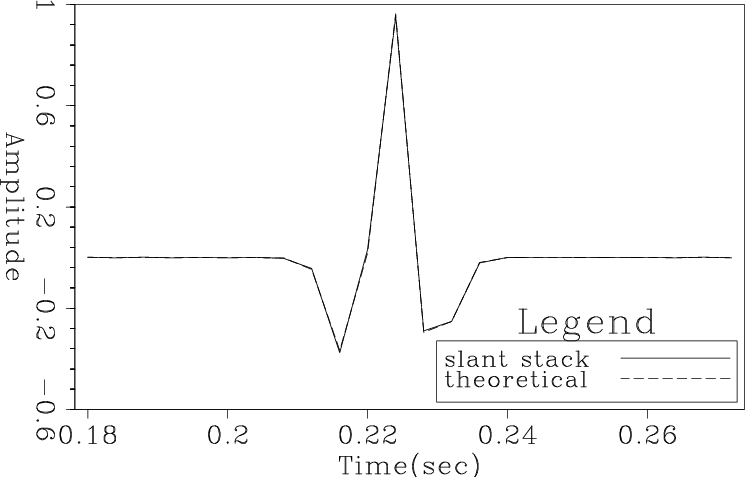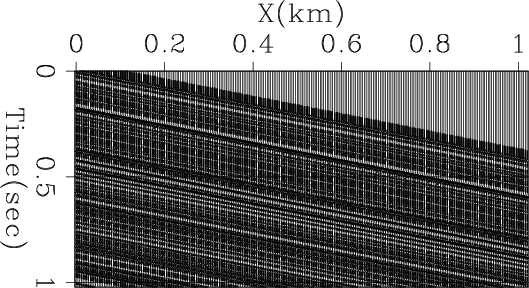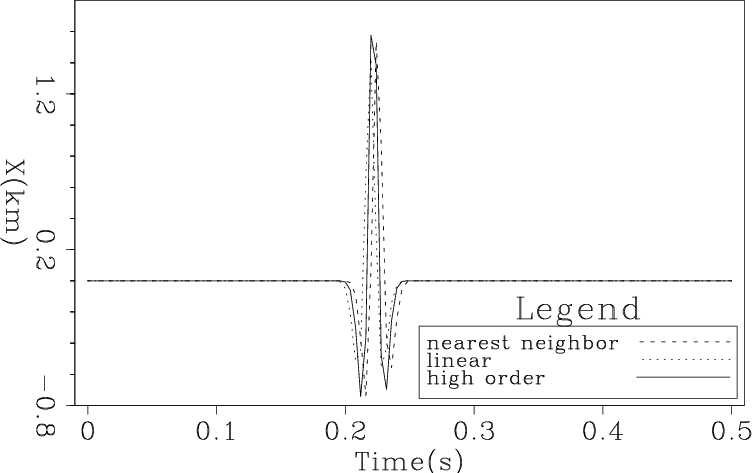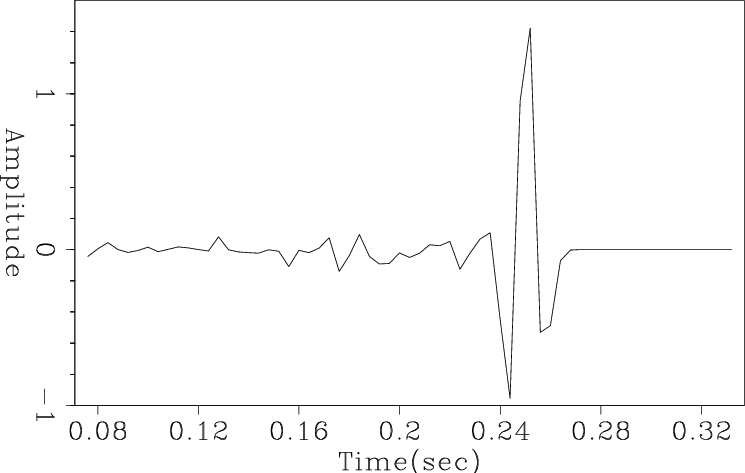|
|
|
|
Integral operator quality from low order interpolation or Sometimes nearest neighbor beats linear interpolation |
 dip is at an azimuth of
dip is at an azimuth of
 and the central frequency of the Ricker wavelet is 64.22 Hz, slightly
more than half the Nyquist frequency. The wavelet
was imposed by calculating the analytic Ricker formula directly onto the
trace samples and not by post-convolving a spike trace synthetic.
and the central frequency of the Ricker wavelet is 64.22 Hz, slightly
more than half the Nyquist frequency. The wavelet
was imposed by calculating the analytic Ricker formula directly onto the
trace samples and not by post-convolving a spike trace synthetic.
|
dipsynth
Figure 4. Dipping 3D synthetic used for slant stack test. |

|
|---|---|
|
|
|
sstacknn
Figure 5. Comparision of the perfect theoretical result with the output of slant stacking the data in Fig. 4 parallel to the planar event using nearest-neighbor interpolation. |

|
|---|---|
|
|
|
sstacklin
Figure 6. Comparision of the perfect theoretical result with the output of slant stacking the data in Fig. 4 parallel to the planar event using linear interpolation. |

|
|---|---|
|
|
|
sstackspectnn
Figure 7. Comparision of the perfect theoretical result with the output of slant stacking the data in Fig. 4 parallel to the planar event using nearest-neighbor interpolation followed by spectral compensation with the reciprocal of formula 1. |

|
|---|---|
|
|
Of course, field data have many events, not just one, and summation operations will generally involve both constructive and destructive summation. Taking a first look at this topic, I modified the planar synthetic to have about 75 uniformly distributed individual parallel plane arrivals with amplitudes constructed according to a Gaussian distribution. (Figure 8.) Using this synthetic, I deliberately slant stacked horizontally (Fig. 10 which requires no interpolation) and again at a dip that was not parallel to the plane of the synthetic. (For Fig. 11 I opted to interchange the X and Y axis dips.) It is clear that nearest-neighbor interpolation created just about as much destructive cancellation as one would expect from a high order interpolation.
|
simpleranddip
Figure 8. First slice of dipping 3D synthetic with sparse reflectors and Gaussian amplitude distribution used for slant stack test. |

|
|---|---|
|
|
|
sstackrandnn16
Figure 9. Comparision of nearest neighbor and high order interpolation slant stacking the data in Fig. 8 parallel to the planar event using nearest-neighbor interpolation followed by spectral compensation with the reciprocal of 1. |

|
|---|---|
|
|
|
hstackrandnn
Figure 10. Horizontal stack of the data in Fig. 8 gained by a factor of 100 over that in Fig. 9. |

|
|---|---|
|
|
|
dstackrandnn
Figure 11. Slant stack over a non-parallel direction of the data in Fig. 8 gained by a factor of 100 over that in Fig. 9. |

|
|---|---|
|
|
My second example is another situation where summation is expected to be almost exclusively constructive: 3D normal moveout. Figure 12 shows the result of applying NMO stack to a synthetic (flat dip) 3D CDP with maximum offsets of 12.8 and 25.6 km in the X and Y directions respectively. No spectral reshaping is shown because those results almost perfectly overlay their inputs. This anomaly arises because of NMO stretch which changes the shapes of the waveforms being stacked. In field data statics, deconvolution, and AVO effects will further modify the input waveforms, making spectral compensation analysis complicated and data dependent.
|
NMO3dcombo
Figure 12. NMO stack comparison of nearest-neighbor, linear and high order interpolaton. Here no spectral compensation has been applied. |

|
|---|---|
|
|
Closely related to NMO stack is common reflection surface (CRS) imaging which estimates and sums over prestack specular reflection surfaces (Jäger et al., 2001; Hertweck et al., 2004). I generated and CRS processed a prestack synthetic for a dipping plane and got the result in Figure 13. With the exception of an apparent one sample shift, probably a small coding bug, again nearest-neighbor did a fine job and outperformed linear linear interpolation.
|
Prestack3Dcombo
Figure 13. CRS zero-offset trace for a dipping planar synthetic using nearest neighbor, linear and high-order interpolation. |

|
|---|---|
|
|
Transitioning further into the balance between constructive and destructive interference, for a fourth example, I poststack migrated the synthetic of Fig. 4 with the same constant velocity used to create it. Using nearest-neighbor interpolation, the output at the first inline and crossline trace location is shown in Figure 14. Linear interpolation produces Figure 15 and highly accurate interpolation produces 16. In this case, increasing the order of the interpolant does increase accuracy, however the level of residual artifact is disconcerting.
|
mig3Dnn
Figure 14. Poststack 3D Kirchhoff time migration of the dipping planar synthetic using just nearest-neighbor interpolation. |

|
|---|---|
|
|
|
mig3Dlin
Figure 15. Poststack 3D Kirchhoff time migration of the dipping planar synthetic using linear interpolation. |

|
|---|---|
|
|
|
mig3Dnn16
Figure 16. Poststack 3D Kirchhoff time migration of the dipping planar synthetic using high-order interpolation. |

|
|---|---|
|
|
The fundamental difference between the last example and the previous ones is that poststack Kirchhoff migration sums only a few samples coherently to form an image point sample. With prestack Kirchhoff, however, the number of coherent samples forming an image point sample is much larger. Figures 17 and 18 show 3D prestack Kirchhoff migration of a horizontal planar event. (Couldn't get the dipping plane version working in time.) There is no longer annoying precursor noise in these results.
|
Kirchnn
Figure 17. Prestack 3D Kirchhoff time migration of a horizontal planar synthetic using just nearest-neighbor interpolation. No attempt was made to taper aperture or apply phase corrections. |

|
|---|---|
|
|
|
Kirchlin
Figure 18. Poststack 3D Kirchhoff time migration of a horizontal planar synthetic using linear interpolation. No attempt was made to taper aperture or apply phase corrections. |

|
|---|---|
|
|
|
|
|
|
Integral operator quality from low order interpolation or Sometimes nearest neighbor beats linear interpolation |